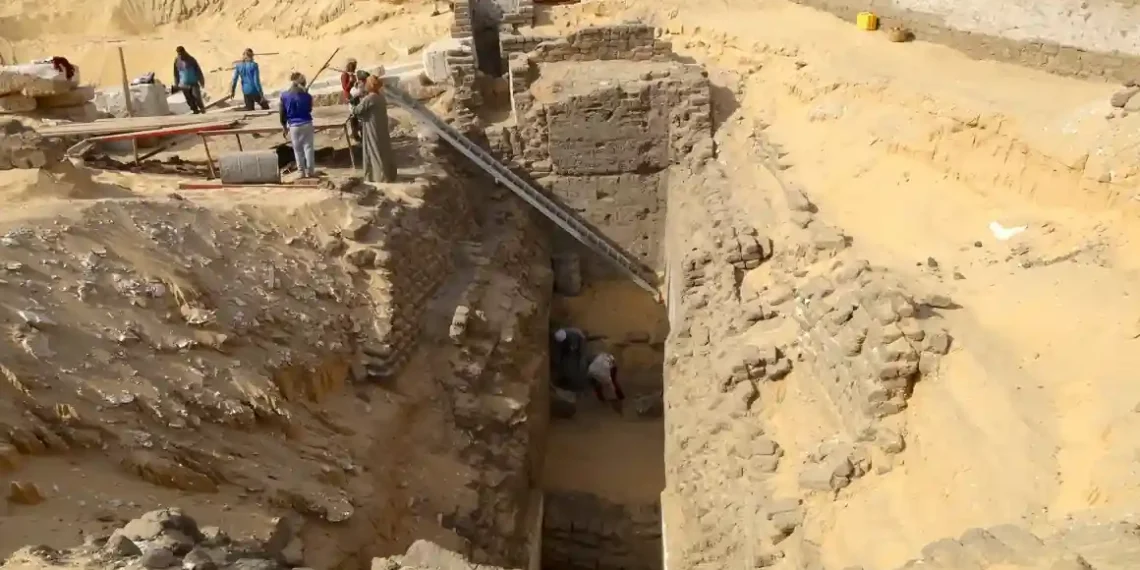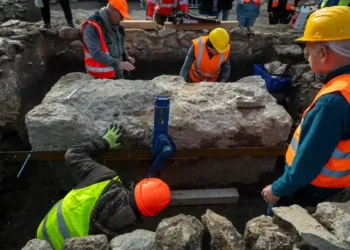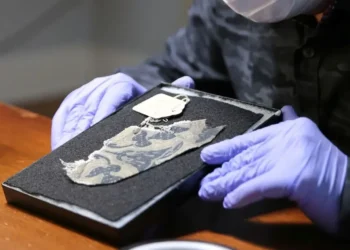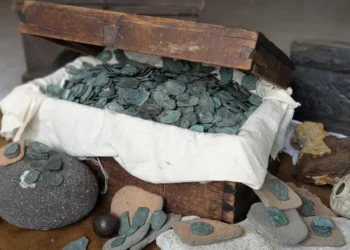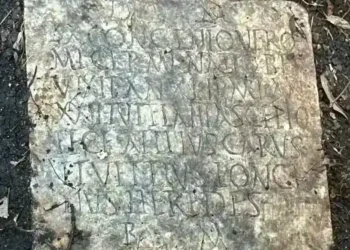Archaeologists Uncover Mysterious Ancient Egyptian Tomb
In a groundbreaking discovery, archaeologists have uncovered a massive, ancient Egyptian tomb that dates back over 3,600 years, shedding new light on a forgotten dynasty and a mystery king.
The tomb, found in January at Abydos in Egypt, is a remarkable find, with multiple chambers and a decorated entryway. However, despite its grandeur, the identity of the tomb’s owner remains a puzzle. Graverobbers had damaged the hieroglyphic texts at the tomb’s entrance, making the king’s name unreadable, according to a report from the Penn Museum at the University of Pennsylvania.
What makes this discovery particularly intriguing is the lack of skeletal remains. Without these, pinpointing the tomb’s royal occupant is challenging. However, experts believe the tomb may belong to a king who ruled Upper Egypt during the Second Intermediate Period, a time marked by political fragmentation. This period, between 1640 and 1540 BC, saw the rise of the Abydos Dynasty—one of the least understood ruling lineages in Egyptian history.
“This is an enigmatic dynasty, largely forgotten in ancient records due to the political chaos of the time,” said Josef Wegner, an Egyptologist and the lead researcher on the excavation. “This tomb opens up new avenues to explore and better understand the Abydos Dynasty.”
The tomb was found deep underground—nearly 23 feet (7 meters)—at the site of an ancient necropolis, also known as the “City of the Dead.” Abydos, considered one of the most sacred sites in ancient Egypt, was historically associated with Osiris, the god of the underworld, and was a favored burial ground for the earliest pharaohs. The necropolis expanded over centuries, with tombs built for royalty from various dynasties.
Wegner and his team had previously discovered another tomb in Abydos that confirmed the existence of the Abydos Dynasty. This discovery, made more than a decade ago, revealed the tomb of King Seneb-Kay—an entirely unknown pharaoh who was absent from traditional historical records. To date, Seneb-Kay’s tomb is the only one with a preserved name.
The newly found tomb, however, is significantly larger, suggesting it may belong to a predecessor of Seneb-Kay. It is located in a section of the necropolis believed to be older, which strengthens the theory that the tomb is linked to an earlier king of the Abydos Dynasty.
While the tomb’s architectural style closely resembles Seneb-Kay’s, it is much more expansive. The main chamber measures approximately 6.2 feet (1.9 meters) wide and nearly 20 feet (6 meters) long. Experts speculate that the tomb may belong to King Senaiib or King Paentjeni, two rulers mentioned in limited archaeological records.
“There’s a chance it could be an entirely unknown king,” Wegner added. “We don’t think we have all the names of the Abydos kings—many of them were never recorded.”
Although the tomb lacks clear inscriptions identifying its occupant, researchers did find two painted images of the goddesses Isis and Nephthys, often associated with mourning rituals. These images offer valuable insights into the funerary customs of the time.
The team plans to expand their excavation efforts in the area, exploring over 100,000 square feet of desert terrain in the hopes of uncovering more tombs. “We could discover 12 to 15 more kings from this dynasty,” Wegner said. To aid their search, they’ll use advanced technologies such as ground-penetrating radar and magnetometry to map underground structures.
Salima Ikram, an Egyptologist at the American University in Cairo, expressed her excitement over the find: “This discovery confirms that there was a significant royal cemetery in Abydos during this time. It gives us more information about royal tomb architecture and provides clues about the kings of this elusive dynasty.”
While the identity of the tomb’s owner remains uncertain, this discovery is already reshaping our understanding of this long-lost period in Egyptian history. “These kinds of finds challenge our previous conceptions and enrich our understanding of Egyptian history,” said Laurel Bestock, an Egyptologist at Brown University. “They remind us how incomplete the historical record can be, and how much more there is to uncover.”
For now, the tomb remains a mystery, but the ongoing excavation promises more surprises as archaeologists continue to explore Egypt’s ancient past. As Wegner puts it, “In archaeology, you never know what twists and turns the evidence will lead to, and that’s what makes it so exciting.”
This article was rewritten by JournosNews.com based on verified reporting from trusted sources. The content has been independently reviewed, fact-checked, and edited for accuracy, neutrality, tone, and global readability in accordance with Google News and AdSense standards.
All opinions, quotes, or statements from contributors, experts, or sourced organizations do not necessarily reflect the views of JournosNews.com. JournosNews.com maintains full editorial independence from any external funders, sponsors, or organizations.
Stay informed with JournosNews.com — your trusted source for verified global reporting and in-depth analysis. Follow us on Google News, BlueSky, and X for real-time updates.
